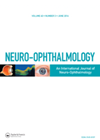Long-term use of botulinum toxin for hemifacial spasm and blepharospasm
1 February 2022
| Claire Howard
|
EYE - Neuro-ophthalmology
|
Botulinum neurotoxin, benign essential blepharospasm, hemifacial spasm, tolerance
The authors conducted a retrospective review of clinical / procedure documentation for consecutive blepharospasm (BEB) and hemifacial spasm (HFS) patients undergoing treatment with onabotulinum toxin A (Botox) in one clinic setting over the past 20 years. They report on the...






